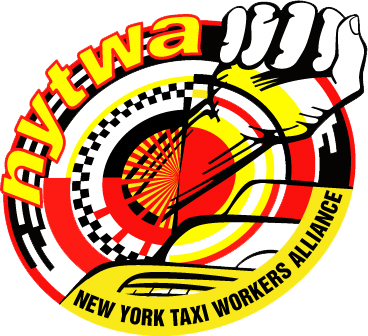Our Vehicle Cap Victory!
Why Our Vehicle Cap Victory Matters
The For-Hire-Vehicle (FHV) Vehicle Cap is the foundation of our fight for a living wage for all NYC professional drivers. Without the cap, companies would be able to keep flooding our streets with more and more cars – leaving fewer fares for each driver. Too many cars means less work for all drivers and more time stuck in traffic. Cars in Manhattan traveled 30% slower in November 2018 compared to November 2010 – at just 4.3 miles per hour.
App-dispatched vehicles like Uber, Lyft, Juno, and Via now account for 30% of all traffic in Manhattan. Meanwhile, app drivers are empty and without a fare 41% of the time in Manhattan’s Central Business District (CBD). And App drivers are still making under the minimum wage they were promised.
In addition to winning a yearlong extension of the lifesaving vehicle cap, we also won a rule that will stop app companies from oversaturating the Central Business District with too many cars at once. App Companies must reduce the amount of time their cars are empty and without a fare in the CBD from 41% to 36% -- and and eventually down to 31%!
The TLC Passed These Proposals on August 7, 2019:
1. Continue Cap on new FHV Vehicle Licenses until August 2020; then review every 6-months
2. Require Uber, Lyft, Via, and Juno to reduce the amount of time their cars are empty 96th Street and below in Manhattan from the current 41% to 36% by February 1, 2020 and then down to 31% by August 1, 2020.
3. Allow App companies to dispatch vehicles affiliated with livery bases and liveries to dispatch to cars affiliated with black car bases
App Drivers Who Want to Buy a Car Can Still Get a Vehicle License
Here’s how:
1. Wheel-Chair-Accessible vehicles
2. Electric Vehicles; or
3. Any vehicle type for drivers who were already in lease-to-own agreements as of August 14, 2018
Key Findings from the Study Authorized by the City Council, Conducted by the Taxi & Limousine Commission and Department of Transportation
There has been a 200% growth in FHV cars from 2010 to 2019.
There has been a 200% increase in the number of FHV from 2010 to 2019: 40,000 in 2010 to over 120,000 in 2019
Uber, Lyft, Via and Juno alone have 85,000 out of the 120,000 FHVs in the industry
There were 78,530 App-affiliated cars in August 2018 versus 85,000 today
The new rules would allow companies to dispatch to remaining 35,000 FHV cars that are not affiliated by App bases
15,000 new vehicle licenses were processed since the August 2018 Cap; but with lack of renewals, the actual change in number of cars has been 6,500 additional cars today compared to one year ago
Attrition rates (non-renewal of vehicle license) remain high despite the Cap:
The attrition rate has been 25% - 28% after Cap, compared to 33% prior to the Cap
During the 1-year Cap period, overall growth in trips has continued, while wait times for passengers have come down.
App trips have grown citywide from 1.9 million in Jan. 2015 to 24 million in March 2019
The number of Taxi and FHV trips in Manhattan core has grown from 16 million per month in Jan 2015 to 32 million per month in March 2019
From August 2018 to June 2019, App trips in outer boroughs increased:
43% in Bronx
15% in Brooklyn
21% in Manhattan (outside of core)
29% in Queens
62% in Staten Island
Wait times have decreased to 8 minutes on average city-wide since the Cap and Utilization Rules:
More neighborhoods in Manhattan, Bronx, Brooklyn, and Queens now have wait times below 5 minutes
Vehicle Cap Background
On August 8, 2018, after months of campaigning and 25 different campaign actions, the New York City Council passed historic first-time regulations on App Companies like Uber and Lyft, including a cap on the number of for-hire-vehicles (FHV’s). The city issued a 1-year moratorium on new licenses with the exception of wheelchair accessible vehicles (WAV’s).
The law also required the Taxi and Limousine Commission to study driver income and well-being, traffic congestion, vehicle utilization rates and consumer access to in different geographic areas during the 1-year period.
For thirty years, four factors have determined driver incomes: 1) rate of fare 2) operating expenses 3) number of trips and 4) number of vehicles. It’s a four factor formula that decides at the end of a grueling shift whether or not a driver takes home a livable income or sinks into poverty and how that income will stabilize.
While 13,437 yellow taxi medallions have been issued by the city along with 18,000 green cab licenses in 2013, only 10,000 yellow taxis and 4,000 green cabs are operating on the streets today. Meanwhile, Uber, Lyft, Juno, and Via have saturated the streets with over 80,000 vehicles since 2012, making it impossible for drivers in any sector to receive enough fares. Now, with the vehicle cap extended for another year, we can build upon its foundation to win a Raise for All Drivers, Job Security and Livable Incomes.
2018 Campaign
In 2018, we had over 25 different campaign actions to win a historic first-time victory against App Companies,including the vehicle cap. Scroll through to see some of our photos from last year’s actions below!
Watch our 2018 Year-in-Review video
Check out photos and videos from the 2019 Vehicle Cap Campaign!
Thank you to the hundreds of drivers who mobilized to protect our vehicle cap victory that lays the foundation to win MORE!
We won!!!!! pic.twitter.com/qk9wqhCS9u
— NY Taxi Workers (@NYTWA) August 7, 2019













